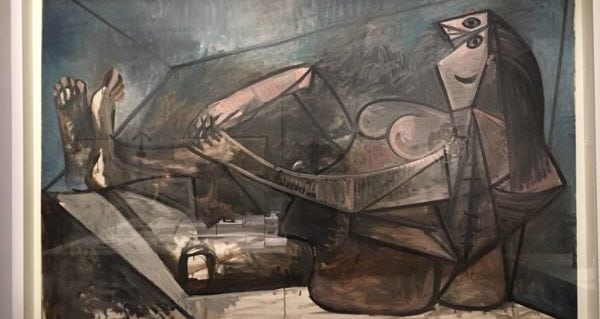 Last week, thousands of Montrealers began to experience what I expect will gradually become a new phenomenon in global art gallery visitation – viewing art to get out of the heat.
Last week, thousands of Montrealers began to experience what I expect will gradually become a new phenomenon in global art gallery visitation – viewing art to get out of the heat.
The heat wave (CBC news referred to it as “a heat event”) really descended on the city on the previous weekend, with Saturday’s temperatures reaching the low 30C range. With the humidity index (or humidex) considered, the net effect actually grew into the low 40C range. Sunday was hotter than Saturday, and Monday hotter still. And the heat wave continued through the week.
We were there to attend the Montreal International Jazz Festival with two other couples, from Washington D.C., and St. Louis, Mo. They were both accustomed to long bouts of extreme summer heat but even so, they noticed the Montreal humidity’s impact and counselled us Western Canadians to go slow and stay inside, out of the mid-day sun.
And so we spent an hour in spirited discussion about how to plan Saturday’s activities before a magnificent Dee Dee Bridgewater evening concert began at Place des Arts. We eventually settled on a double-decker bus tour of the city, followed by an afternoon at the Musee des Beaux-Arts, Montreal’s largest museum on the historic Golden Square Mile on Sherbrooke Street.
The bus tour, starting at 10 a.m., was bloody hot. We swung down to the Ancienne Ville and the riverfront wharfs, and then circled back up to Sherbrooke and eventually climbed up Mount Royal to the famous St. Joseph’s Oratory and a spectacular city viewpoint.
Luckily we had just been given Georgetown University Hoyas baseball hats by our D.C. pals and had put on sunscreen, because it was cloudless day and 34C on the open top deck of the bus. The total effect was not enhanced by a woman in the seat in front of me with an aerosol can of sunscreen. Every time she reached back and sprayed her exposed shoulders and neck, clouds of creamy vapour shot into my eyes and face.
After the bus tour, we had decided to spend the afternoon out of the sun and the magnificent Picasso exhibition, D’Afrique Aux Ameriques: Picasso En Face-A-Face, D’Hier A Aujourd’hui, was enticing to us all. Apparently the central idea behind the show was the impact of African art on Pablo Picasso and his contemporaries, and the redefinition of “tribal and primitive art” as sophisticated expressions of fellow artists who worked with similar motivations and aesthetics.
Thinking of Picasso’s oeuvre, and especially the elliptical eyes of so many of his famous portraits (check out Les Demoiselles d’Avignon, for example), I was immediately intrigued. Had he copied African artists whose work he had discovered at the Musee d’Ethnographie du Trocadero in Paris?
Meanwhile, the outside temperature as recorded on my cellphone was now 35C. We opted to hike up Mansfield, turn left on Sherbrooke, see the exhibition and have lunch in the museum.
The new Jean-Noel Desmarais Pavilion (one of five that form the Musee des Beaux-Arts campus) was designed by Moshe Safdie and built in 1991. It contains the modern and contemporary art collections of the musee, and houses travelling temporary exhibitions like D’Afrique Aux Ameriques.
Most importantly for me that day, it is supremely air conditioned, and the effect of stepping inside from the street was sublime. And all around us, several hundred other people were sharing the same effect. A common topic in the ticket queue was just how lovely it was to be inside, away from the roiling heat on Sherbrooke Street.
The Picasso exhibition was combined with the works of numerous of his contemporaries, and many anonymous African artists whose work was originally collected as ethnographic objects from Africa, as if the continent was a country.
Somehow, my mind kept connecting Africa to heat, not art. As the Picasso show eventually came to an end in a magnificent final gallery of contemporary photography, I strangely felt myself wanting to see the musee’s core collection of Group of Seven paintings of Quebec snowscapes, Rocky Mountain national parks, and Inuit art. How had this association been formed, I wondered?
After a fine bistro lunch in the musee, we headed back to our hotel, a mere three blocks away. The wall of heat that hit us on the street was remarkable.
At least 34 people have died in southern Quebec as a result of the heat. Thank god for the temporary respite of art.
Troy Media columnist Mike Robinson has been CEO of three Canadian NGOs: the Arctic Institute of North America, the Glenbow Museum and the Bill Reid Gallery.
The views, opinions and positions expressed by columnists and contributors are the author’s alone. They do not inherently or expressly reflect the views, opinions and/or positions of our publication.





